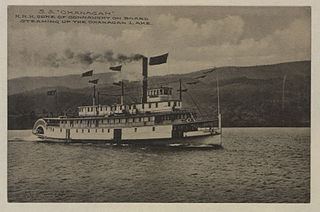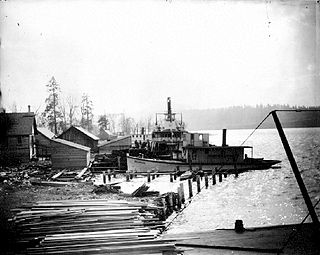Related Research Articles

Okanagan Lake is a large, deep lake in the Okanagan Valley of British Columbia, Canada. The lake is 135 km (84 mi) long, between 4 and 5 km wide, and has a surface area of 348 km2.

The Okanagan, also known as the Okanagan Valley and sometimes as the Okanagan Country, is a region in the Canadian province of British Columbia defined by the basin of Okanagan Lake and the Canadian portion of the Okanagan River. It is part of the Okanagan Country, extending into the United States as Okanogan County in north-central Washington. According to the 2016 Canadian census, the region's population is 362,258. The primary city is Kelowna.

Naramata is a community within the Regional District of Okanagan–Similkameen in British Columbia, Canada. Naramata is situated in the Okanagan Valley on the southeast shore of Lake Okanagan, to the north of Penticton. In 2010, Naramata was the second Community in Canada to be designated Cittaslow. On the edge of the northernmost reaches of the Sonoran desert, Naramata is situated in Canada's only semi-desert region. The topography is reminiscent of a blend of Southern California and Southern Italy.

SS Sicamous is a large five decked sternwheeler commissioned by the Canadian Pacific Railway (CPR) and built by the Western Dry Dock and Shipbuilding Company for Okanagan Lake service between the fruit communities of Penticton, and other towns of Kelowna and Vernon, British Columbia. Launched in 1914, Sicamous ran for many years connecting rail lines and areas. The vessel operated until 1937 and is currently beached as a part of a heritage shipyard operated by the S.S. Sicamous Restoration Society in Penticton. The vessel today is operated both as a museum and events and banquet facility.

Okanagan Landing was an unincorporated settlement and steamboat port at the north end of Okanagan Lake in the Southern Interior of British Columbia. Located southwest of the city of Vernon, it was the terminus station for the Shuswap and Okanagan Railway and served as the port and shipyard for steamboats operating to the south, as well as a transfer barge slip.

SS Naramata is a steam tug commissioned by the Canadian Pacific Railway (CPR) company. She pushed barges and broke ice on Okanagan Lake from 1914 to 1967. After over 50 years of service, the boat was eventually retired and left to rest in Penticton beside her sister ship, SS Sicamous. In 2001, she was purchased by the S.S. Sicamous Restoration Society and is currently undergoing extensive renovations. Naramata is the only interior steam tug to be preserved in the province of British Columbia, Canada.

SS Okanagan was a steamship owned and operated by the Canadian Pacific Railway Lake and River Service. The vessel was constructed in 1906 at Okanagan Landing and launched in 1907, becoming Okanagan Lake's second steamship. She linked the transportation hubs at both the north and south ends of Okanagan Lake (Vernon and Penticton, respectively, aiding the development of interior British Columbia with other steamships of the 1900s. The ship was retired in 1934 and sold for scrap and spare parts. Only the Stern Saloon, a room in the back of the upper deck, remains. It was moved to the SS Sicamous Heritage Park in Penticton in 2002, to undergo restoration work.

SS Kelowna was a tow boat that was operational between the years 1892–1912 on Okanagan Lake in British Columbia. It was later dismantled in Penticton.
MV Kelowna-Westbank was a diesel-powered ferry that operated on Okanagan Lake in British Columbia, Canada beginning in 1927. Although private ferry service had long been established on the lake, Kelowna-Westbank became the first provincial government-operated ferry upon her launch on February 21, 1927.
MV Skookum, not to be confused with the 1906 ferry MV Skookum, was a ferry that linked the communities of Naramata and Summerland on Okanagan Lake in British Columbia, Canada.
MV Rattlesnake was a ferry launched in 1907 to operate between the communities of Summerland and Naramata on Okanagan Lake in British Columbia, Canada. Rattlesnake was originally called Orillia before she was bought and renamed by pioneer John Moore Robinson, owner of the Okanagan Lake Boat Company. She was launched in 1907, becoming the Company's second boat after the tug Maude-Moore, though she was the third Summerland-Naramata ferry after Maude-Moore and the smaller Mallard. Rattlesnake was first used as Robinson's private launch before beginning ferry service. She was a short, squat, slow and ugly tug that rode low in the water, but she was also powerful and she tugged cement pipe from factories, as well as hay and logs. In 1911, the Okanagan Lake Boat Company was sold to Peter Roe, who replaced Maude-Moore and Rattlesnake with two gas boats.
MV Trepanier was a ferry that operated between the communities of Naramata and Summerland on Okanagan Lake in British Columbia, Canada. Trepanier was added to the Okanagan Lake Boat Company's fleet in 1912. The company's owner, Peter Roe, operated her and the earlier MV Skookum with his brothers, Fred and Gerald. Trepanier was purchased by Captain J. A. Noyes and his brother, I. R. Noyes, and used for pleasure trips until November 1913, when the larger MV Skookum, built in 1912 and not to be confused with the Skookum mentioned earlier, collided with the Canadian Pacific Railway company-operated SS Castlegar and sank. Although Trepanier was smaller than Skookum, she was used as a replacement and began regular ferry service soon after the crash.
Colleen was a rowboat used on Okanagan Lake in British Columbia, Canada in the late 1800s and early 1900s. She belonged to the Reverend Thomas Greene and served many early settlers and pioneers of the Okanagan, including W. D. Walker and Thomas Ellis, the earliest European settler in Penticton, British Columbia.
SS Maude-Moore was a wood-burning screw steamer that provided a ferry service between the communities of Summerland, Naramata, and Penticton on Okanagan Lake in British Columbia, Canada.
MV Mallard, later Kaleden, was a ferry that linked the communities of Summerland and Naramata on Okanagan Lake in British Columbia, Canada from 1908 to 1910, and later served Skaha Lake and Kaleden, British Columbia, under the name Kaleden.
Ruth Shorts was pioneer Captain Thomas Shorts' first boat on Okanagan Lake in British Columbia, Canada and starting with her, Shorts was the first boater on the lake, beginning a long history of ships and steam transportation that enabled the development of the Okanagan. In the early 1880s, Shorts thought of beginning a freight business on the lake and had Pringle and Hamill of Lansdowne build a rowboat with a capacity of 2.5 tons. The boat was 22 feet (6.7 m) long and had a small sail. Shorts named the boat Ruth Shorts after his mother and he began service in 1883. There was no set schedule, but the round trip generally took nine days and Shorts rowed in all weather for three years, averaging a passenger a month. He made about CAD$6000 rowing before venturing into steam with Mary Victoria Greenhow in 1886, only to lose his earnings.
SS Jubilee was the second steamship on Okanagan Lake in British Columbia, Canada, owned and operated by Captain Thomas Shorts. She was built by Shorts and carpenter John Hamilton in 1887 while they were waiting for a new boiler to come in for their first steamship, SS Mary Victoria Greenhow, which needed new machinery. When it arrived, they decided to put the new boiler in the new 30 feet (9.1 m) by 8 feet (2.4 m) Jubilee instead and they put Mary Victoria Greenhow's engine in Jubilee as well. She was launched at the Okanagan Landing shipyard at 3:30 p.m. on September 22, 1887. Jubilee took about two weeks per round trip on the lake. A gold strike on Granite Creek in the Similkameen River in 1889 created business for Jubilee and Shorts built a barge to help her. However, the strike didn't last long and the barge was beached. Jubilee was also short-lived, as she froze in ice at Okanagan Landing during a cold spell in the winter of 1889–1890. She sank and in the spring, her machinery was put in Shorts' new barge, City of Vernon. The engine was reinstalled in several more ships, and the retired engine was used in a shingle mill for cutting firewood at Trinity Valley starting in 1906. Finally, Mr. and Mrs. G. H. Worth of Vernon, British Columbia, who had owned and used it for many years, donated it to the Vernon Museum and Archives in November 1957.
SS Mary Victoria Greenhow (MVG) was the first steamboat on Okanagan Lake in British Columbia, Canada. She was built by Captain Thomas Shorts and Thomas Greenhow and although she was not perfect, she was the harbinger of a long and significant line of steamships in the Okanagan.
MV Skookum, also known as Tut Tut and not to be confused with MV Skookum (1912), was a ferry that operated on Okanagan Lake in British Columbia, Canada starting on April 2, 1906. She was the first official, government-subsidized ferry on the lake to connect the communities of Kelowna and Westbank.
Chute Lake is a small lake on the east side of Okanagan Mountain, in the Okanagan Valley in the southern interior of British Columbia. There is one access road, the Chute Lake Road, which is a gravel road connecting Naramata in the south, to Kelowna in the north. Chute lake can also be accessed via the Kettle Valley Rail Trail from Kelowna or Naramata. The Chute Lake Resort is located on the lake's southwest shore.
References
- ↑ Nuttall, Mrs. W. (1958). "Naramata—Smile of Manitou". The twenty-second report of the Okanagan Historical Society. p. 53. Retrieved 18 August 2015.
- ↑ "Naramata in Retrospect". The twenty-ninth report of the Okanagan Historical Society. 1965. p. 179. Retrieved 15 August 2015.